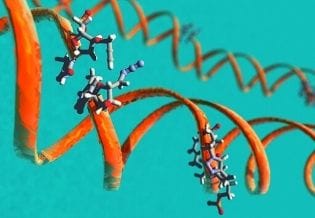Aims & Scope
Core Research Domains
DNA Structure & Dynamics
- DNA topology, supercoiling, and conformational dynamics
- DNA-protein interactions and chromatin architecture
- DNA damage, repair mechanisms, and mutagenesis
- DNA replication fidelity and replication fork dynamics
- DNA methylation patterns and epigenetic modifications
- DNA nanotechnology and origami structures
RNA Biology & Regulation
- RNA processing, splicing, and post-transcriptional modifications
- Non-coding RNA function (miRNA, lncRNA, circRNA, siRNA)
- RNA-protein complexes and ribonucleoprotein assembly
- RNA stability, degradation pathways, and quality control
- RNA localization and transport mechanisms
- RNA structure-function relationships and folding dynamics
Gene Expression & Regulation
- Transcriptional regulation and promoter architecture
- Enhancer-promoter interactions and 3D genome organization
- Transcription factor binding dynamics and cooperativity
- RNA polymerase mechanisms and transcription elongation
- Translational control and ribosome profiling
- Gene silencing mechanisms and epigenetic regulation
Genomics & Genome Engineering
- Genome sequencing technologies and assembly methods
- Comparative genomics and evolutionary analysis
- CRISPR-Cas systems and genome editing applications
- Genetic variation, SNPs, and structural variants
- Mitochondrial and chloroplast genome organization
- Transposable elements and genome plasticity
Secondary Focus Areas
Nucleic Acid Technologies
Novel methods for nucleic acid synthesis, modification, detection, and sequencing. Development of DNA/RNA-based biosensors, diagnostic platforms, and analytical tools. Advances in single-molecule techniques and high-throughput screening approaches.
Computational Nucleic Acid Biology
Bioinformatics tools for genome annotation, RNA structure prediction, and sequence analysis. Machine learning applications in predicting DNA-protein binding, RNA folding, and regulatory element identification. Algorithm development for next-generation sequencing data analysis.
Synthetic Biology Applications
Design and construction of synthetic genetic circuits and regulatory networks. Artificial nucleic acid systems for biotechnology applications. DNA data storage and molecular computing. Engineered RNA devices for cellular control and therapeutic applications.
Nucleic Acids in Disease
Molecular mechanisms of genetic disorders at the nucleic acid level. DNA/RNA biomarkers for disease diagnosis and prognosis. Nucleic acid-based therapeutics including antisense oligonucleotides, RNA interference, and gene therapy vectors. Pharmacogenomics and personalized medicine approaches.
Emerging Research Areas
Article Types & Editorial Priorities
Expedited Review (18 days to first decision)
Regular Review (18 days to first decision)
Selective Acceptance (requires exceptional novelty)
Editorial Standards & Requirements
Reporting Guidelines
- ARRIVE guidelines for animal studies
- MIAME standards for microarray data
- MINSEQE for sequencing experiments
- MIQE for qPCR studies
- STROBE for observational studies
Data Availability
- Raw sequencing data in public repositories (SRA, ENA, GEO)
- Genome assemblies deposited in GenBank/EMBL
- Structural data in PDB or EMDB
- Code and scripts in GitHub or Zenodo
- Data availability statement required
Ethics & Compliance
- IRB/Ethics committee approval for human subjects
- IACUC approval for animal research
- Informed consent documentation
- Biosafety and biosecurity compliance
- Dual-use research oversight when applicable
Preprint & Prior Publication
- Preprints on bioRxiv, medRxiv welcomed
- Conference abstracts acceptable
- Thesis chapters considered if unpublished
- No prior publication in peer-reviewed journals
- Preprint DOI must be disclosed at submission
Ready to Submit Your Research?
If your work advances understanding of DNA or RNA biology through rigorous experimental or computational approaches, we invite you to submit to JDRR. With an acceptance rate of 53%, average time to first decision of 18 days, and publication within 3 days of acceptance (50 days from submission), JDRR offers a rapid and transparent path for disseminating high-quality nucleic acid research.
Submit Manuscript

